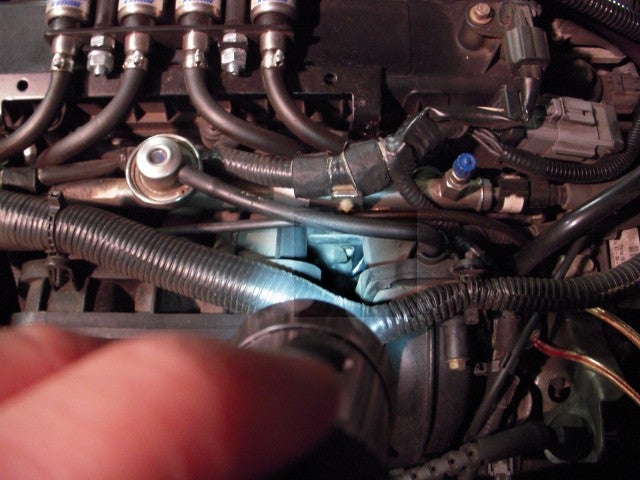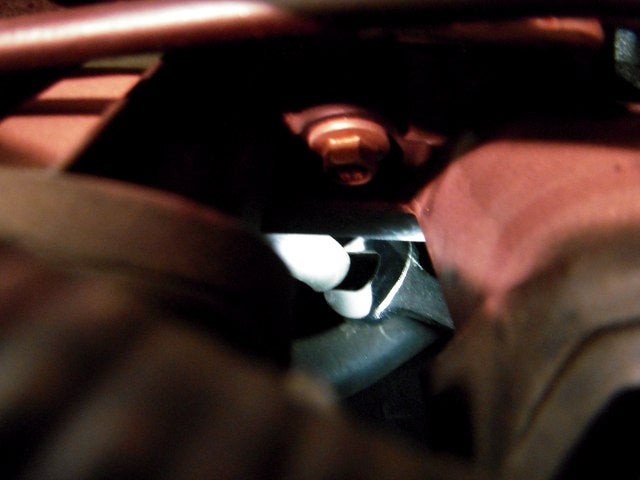Registrations
We now manually approve all new user accounts due to a large influx of spam bots. Accounts are normally approved within 48 hours.
If you need any help with using this Wiki, please ask here: TalkFord.com Wiki Submission Forum
Difference between revisions of "Inlet Manifold Fault - Duratec"
52graphite (Talk | contribs) (Draft) |
52graphite (Talk | contribs) |
||
| Line 11: | Line 11: | ||
== How can I tell if I'm affected? == | == How can I tell if I'm affected? == | ||
| − | The easiest way to establish if your car is affected is to measure the diameter of the oil separator pipe. This seems to have been changed at the same time as the revised manifold was introduced. If the pipe is ½" outside diameter, you have the old manifold; if it's ¾", you have the new one. | + | The easiest way to establish if your car is affected is to measure the diameter of the oil separator pipe. This seems to have been changed at the same time as the revised manifold was introduced. If the pipe is ½" (just under 13mm) outside diameter, you have the old manifold; if it's ¾" (19mm), you have the new one. |
| + | |||
| + | Unfortunately, this pipe isn't particularly easy to see or access to measure. You need to remove the engine cover first, then your best view of it is with a torch down the gap between the rightmost two cylinders as you look at the engine. | ||
| + | |||
| + | The photos below show the pipe being checked with a 15mm open-ended spanner inserted in the gap below the throttle body - the old pipe would fit inside, but as this car has the new pipe, it doesn't fit. You really don't want to drop the spanner - this one has a ring spanner on the other end with an old piece of speaker cable threaded through. You could make a gauge out of stout cardboard if you don't have a suitable spanner. | ||
| + | |||
| + | The car in the photos has been converted to LPG, so ignore the bank of injectors at the top of the first photo. | ||
| + | |||
| + | [[Image:Manifold1.jpg]] | ||
| + | |||
| + | [[Image:Manifold2.jpg]] | ||
| + | |||
| + | == What happens if it breaks? == | ||
| + | |||
| + | Read [http://www.robertjenkins.co.uk/mondeo/index.php Robert Jenkins' article] for the gory details. | ||
| + | |||
| + | == How can I tell if failure is imminent? == | ||
| + | |||
| + | Hold the pointy end of a screwdriver on each inlet tract of your running engine in turn, putting the blunt end to your ear. The usual safety notes apply - don't wear a tie or dangle long hair into a running engine. If you can hear a rattle (as opposed to the normal injector ticking sound), you have a problem. However, no rattle doesn't necessarily mean no problem. | ||
| + | |||
| + | == What can I do about it? == | ||
| + | |||
| + | You have four options: | ||
| + | |||
| + | * Do nothing. | ||
Revision as of 06:30, 24 March 2009
Contents
Background
The 1.8 and 2.0 Duratec-HE petrol engines fitted to Mk3 Mondeos have swirl plates (also called tumble flaps) fitted in the inlet tracts to modify the incoming airflow under certain conditions for allegedly improved smoothness, economy and emissions.
However, the flaps in early vehicles (built up to late 2002) are susceptible to falling apart and getting ingested by the engine. This frequently causes engine damage and has caused several vehicles to be written off. Sometimes this is preceded for a long time by an audible rattle, other times failure is sudden and catastrophic.
Affected vehicles
The exact date of introduction of the revised manifold - which appears to have cured the issue - is not exactly known. The closest we can say at the moment is that a 2.0 litre car built on 28 August 2002 had the old manifold, and a 1.8 litre car built on 4 December 2002 had the revised one.
How can I tell if I'm affected?
The easiest way to establish if your car is affected is to measure the diameter of the oil separator pipe. This seems to have been changed at the same time as the revised manifold was introduced. If the pipe is ½" (just under 13mm) outside diameter, you have the old manifold; if it's ¾" (19mm), you have the new one.
Unfortunately, this pipe isn't particularly easy to see or access to measure. You need to remove the engine cover first, then your best view of it is with a torch down the gap between the rightmost two cylinders as you look at the engine.
The photos below show the pipe being checked with a 15mm open-ended spanner inserted in the gap below the throttle body - the old pipe would fit inside, but as this car has the new pipe, it doesn't fit. You really don't want to drop the spanner - this one has a ring spanner on the other end with an old piece of speaker cable threaded through. You could make a gauge out of stout cardboard if you don't have a suitable spanner.
The car in the photos has been converted to LPG, so ignore the bank of injectors at the top of the first photo.
What happens if it breaks?
Read Robert Jenkins' article for the gory details.
How can I tell if failure is imminent?
Hold the pointy end of a screwdriver on each inlet tract of your running engine in turn, putting the blunt end to your ear. The usual safety notes apply - don't wear a tie or dangle long hair into a running engine. If you can hear a rattle (as opposed to the normal injector ticking sound), you have a problem. However, no rattle doesn't necessarily mean no problem.
What can I do about it?
You have four options:
- Do nothing.


 Your Privacy Choices
Your Privacy Choices